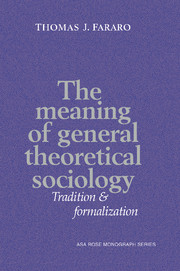Book contents
- Frontmatter
- Contents
- List of Figures and Tables
- Preface
- Introduction
- Chapter 1 A philosophy of general theoretical sociology
- Chapter 2 Dynamical social systems and the key problems
- Chapter 3 Action theory and social order
- Chapter 4 Structuralism and unification
- Summary
- Notes
- References
- Index of names
- Index of subjects
- Other books in the Arnold and Caroline Rose Monograph Series of the American Sociological Association
Chapter 4 - Structuralism and unification
Published online by Cambridge University Press: 10 December 2009
- Frontmatter
- Contents
- List of Figures and Tables
- Preface
- Introduction
- Chapter 1 A philosophy of general theoretical sociology
- Chapter 2 Dynamical social systems and the key problems
- Chapter 3 Action theory and social order
- Chapter 4 Structuralism and unification
- Summary
- Notes
- References
- Index of names
- Index of subjects
- Other books in the Arnold and Caroline Rose Monograph Series of the American Sociological Association
Summary
Introduction
In Chapter 1, a philosophy of theoretical sociology was set out. A process worldview was described, and the claim was made that it, or some very similar process philosophy, is a high-order component of the research tradition of general theoretical sociology. In Chapter 2, this process worldview led to a conception of dynamical social systems. Four types of theorems were described, each an aspect of the analysis of any dynamical social system model. These theorems concern the emergence and forms of social structure, the attractor or repellor classification of such structures, the systematic comparison of attractor structures, and the change of such structures, including both smooth and catastrophic transformations over time. Employing the emerging “do's” and “don'ts” of the general theoretical sociology tradition, two conceptual problems were noted in this development of dynamical social systems theory. These two problems provide the foci for the investigations, respectively, in the preceding chapter and in this chapter.
The two problems pertain to action theory and structuralism, respectively. The first problem leads to a call for an intelligible explanatory basis for theoretical sociology. Formally, we require generativity. Substantively, we require a model of the single actor entering into interaction. This focus on generativity and action was the basis for the studies in action theory in Chapter 3. It must not be thought that the concern with action theory is in some way a lack of concern with social structure.
- Type
- Chapter
- Information
- The Meaning of General Theoretical SociologyTradition and Formalization, pp. 255 - 341Publisher: Cambridge University PressPrint publication year: 1989



